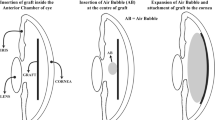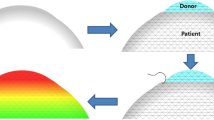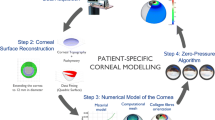Abstract
Cornea transplant involving applanation results in a deformation of the cornea. This deformation combined with a mismatch of dimensional and mechanical properties between donor and recipient corneas gives rise to tension on the transplanted cornea, astigmatism and vision difficulties. Therefore, accurate prediction of deformation of the incision plant during such operations is necessary to minimize complications. In this work, we employed a finite element simulation on a cornea with measured geometry and hyperelastic Mooney–Rivlin mechanical properties to analyze the intended incision plane’s change during corneal applanation. A simulation of the cornea transplant procedure assuming two different geometries to be the same was performed, and the transplanted cornea showed a 5.1% change in the exterior radius. When the proposed method was applied, no change in the radius after transplant was observed. Moreover, a precise matching of the incision plane can be selected for the corneas, and the corneal deformation after an IntraLase-Enabled Keratoplasty (ILEK) corneal transplant procedure is expected to be minimal.









Similar content being viewed by others
References
J.B. Jonas, U. Vossmerbaeumer, J. Refract. Surg. 20, 391 (2004)
R.J. Duffey, D.U. Leaming, J. Refract. Surg. 19, 357 (2003)
S. Richard et al., Corneal Transplantation: Penetrating Keratoplasty (Springer, Cham, 2020)
J.J. Pan et al., Comput. Methods Progr. Biomed. 197, 105679 (2020)
Y.M. Por et al., Am. J. Ophthalmol. 145, 772 (2008)
H.K. Soong, J.B. Malta, Am. J. Ophthalmol. 147, 189 (2009)
S. Fung, F. Aiello, V. Maurino, J. Eye. 30, 553 (2016)
Y.Y. Cheng et al., J. Transplant. 88, 1294 (2009)
R.K. Jha et al., Korean Phys. Soc. 69, 749 (2016)
V. Mazlin et al., Nat. Commun. 11, 1868 (2020)
R.M. Werkmeister et al., Biomed. Opt. Exp. 8(2), 1221 (2017)
G. Holzapfel, Nonlinear Solid Mechanics: A Continuum Approach for Engineering (Wiley, England, 2000)
V. Alastruà et al., J. Biomech. Eng. 128, 150 (2006)
M.R. Bryant, P.J. McDonnell, J. Biomech. Eng. 118, 473 (1996)
A. Pandolfi, F. Manganiello, Biomech. Mod. Mech. Biol. 5, 237 (2006)
I. Simonini, A. Pandolfi, PLoS One 10, 0130426 (2015)
A.S. Roy, W.J. Dupps, J. Biomech. Eng. 133, 011002 (2011)
T.R. Friberg, J.W. Lace, Exp. Eye. Res. 47, 429 (1988)
E. Uchio et al., Br. J. Ophthalmol. 83, 1106 (1999)
F. Cavas-Martínez et al., PLoS ONE 9, 110249 (2014)
W.M. Petroll et al., J. Cornea. 15, 154 (1996)
P.M. Pinsky, D. van der Heide, D. Chernyak, J. Cataract. Refract. Surg. 31, 136 (2005)
H.C. Howland, R.H. Rand, S.R. Lubkin, J. Refract. Surg. 8, 183 (1992)
K.M. Meek, R.H. Newton, J. Refract. Surg. 15, 695 (1999)
C.W. Hong et al., Investig. Ophthalmol. Vis. Sci. 53, 2321 (2012)
M. Kaliske, Comput. Methods Appl. Mech. Eng. 185, 225 (2000)
W. Waseem, M. Sulaiman, A. Alhindi, H. Alhakami, IEEE. Acc. 8, 61576–61592 (2020)
R. Lee et al., J. Eye. 34, 1737 (2020)
Y. Liu et al., Eur. J. Ophthalmol. 31, 976–987 (2020)
T. Ono et al., Sci. Rep. 10, 1 (2020)
A. Pandofi, Eye Vis. 7, 15 (2020)
Acknowledgements
This work was supported by the National Research Foundation of Korea (NRF) (NRF-2020R1A2C3010322 and NRF-2018M3A9D7079485).
Author information
Authors and Affiliations
Corresponding author
Additional information
Publisher's Note
Springer Nature remains neutral with regard to jurisdictional claims in published maps and institutional affiliations.
Rights and permissions
About this article
Cite this article
Joo, J., Kim, B. & Chun, H. Application of computational modeling to improve cornea transplant surgery. J. Korean Phys. Soc. 79, 874–881 (2021). https://doi.org/10.1007/s40042-021-00279-9
Received:
Accepted:
Published:
Issue Date:
DOI: https://doi.org/10.1007/s40042-021-00279-9




